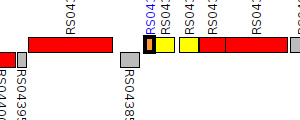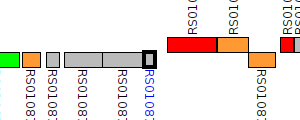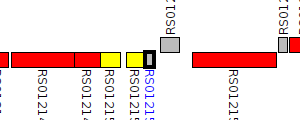In order to generate a more inclusive dataset of Pseudomonas genes mapped to putative in-paralogs and putative orthologs in other Pseudomonas species/strains, we developed a Pseudomonas Orthologous Groups classification system.
To generate ortholog groups, pair-wise DIAMOND searches were run on all genomes in the database to find reciprocal best hits (RBHs) for each gene. These analyses often resulted in multiple candidate genes for RBH status, which were narrowed down by examining the similarity between the query's flanking genes and the hit's flanking genes. If two candidate genes were directly adjacent, they where both accepted as RBHs that involve putative in-parology.
Pairwise intra-genome DIAMOND searches were also performed to acquire in-paralog information (i.e. gene duplications occurring after species divergence). If two genes in one genome were reciprocally more similar to each other than to any gene in the other genomes, the two genes were designated putative in-paralogs. Ortholog groups are built by starting with a seed gene and then adding all genes to which there is a RBH or in-paralog relationship.
Every new gene added to an ortholog group was then treated as a seed gene and the addition process was repeated until all qualifying genes had been added. The result was the development of orthologous groups, specifically generated for Pseudomonas species genomes, which can be used to sort search results.
Pseudomonas Ortholog Group POG004897
| Strain | Locus Tag | Description | Same-Strain Members | Fragment ? | |
|---|---|---|---|---|---|
| Pseudomonas sp. CCOS 191 | CCOS191_RS00405 |
cytochrome C
|
2 same-strain members: CCOS191_RS00405 CCOS191_RS17240 |

|
|
| Pseudomonas sp. CCOS 191 | CCOS191_RS17240 |
cytochrome C
|
2 same-strain members: CCOS191_RS00405 CCOS191_RS17240 |

|
|
| Pseudomonas sp. CF150 | CF150_06991 |
putative cytochrome c5
|
1 member |

|
|
| Pseudomonas sp. FeS53a | SZ55_RS23780 |
cytochrome C
|
2 same-strain members: SZ55_RS23780 SZ55_RS07865 |

|
|
| Pseudomonas sp. FeS53a | SZ55_RS07865 |
cytochrome
|
2 same-strain members: SZ55_RS23780 SZ55_RS07865 |

|
|
| Pseudomonas sp. FGI182 | C163_RS00415 |
cytochrome c-type protein
|
1 member |

|
|
| Pseudomonas sp. FH4 - Assembly GCF_000510915.2 | H097_RS09755 |
cytochrome C
|
2 same-strain members: H097_RS09755 H097_RS04380 |

|
|
| Pseudomonas sp. FH4 - Assembly GCF_000510915.2 | H097_RS04380 |
hypothetical protein
|
2 same-strain members: H097_RS09755 H097_RS04380 |

|
|
| Pseudomonas sp. GM25 | PMI24_02361 |
cytochrome
|
2 same-strain members: PMI24_02361 PMI24_02941 |

|
|
| Pseudomonas sp. GM25 | PMI24_02941 |
cytochrome C
|
2 same-strain members: PMI24_02361 PMI24_02941 |

|
|
| Pseudomonas sp. GM30 | PMI25_002164 |
cytochrome
|
2 same-strain members: PMI25_003149 PMI25_002164 |

|
|
| Pseudomonas sp. GM30 | PMI25_003149 |
cytochrome C
|
2 same-strain members: PMI25_003149 PMI25_002164 |

|
|
| Pseudomonas sp. GM41(2012) | PMI27_002624 |
cytochrome
|
1 member |

|
|
| Pseudomonas sp. H1h | U862_RS0108775 |
cytochrome C
|
2 same-strain members: U862_RS0108775 U862_RS0121510 |

|
|
| Pseudomonas sp. H1h | U862_RS0121510 |
cytochrome
|
2 same-strain members: U862_RS0108775 U862_RS0121510 |

|
|
| Pseudomonas sp. KG01 | ACR52_RS05645 |
cytochrome
|
1 member |

|
|
| Pseudomonas sp. LAIL14HWK12:I12 | D902_RS0104395 |
hypothetical protein
|
1 member |

|
|
| Pseudomonas sp. LAIL14HWK12:I5 | F629_RS0114145 |
cytochrome C
|
1 member |

|
|
| Pseudomonas sp. LAIL14HWK12:I6 | D907_RS0104195 |
cytochrome C
|
1 member |

|
|
| Pseudomonas sp. LAIL14HWK12:I7 | D886_RS0100185 |
cytochrome C
|
1 member |

|